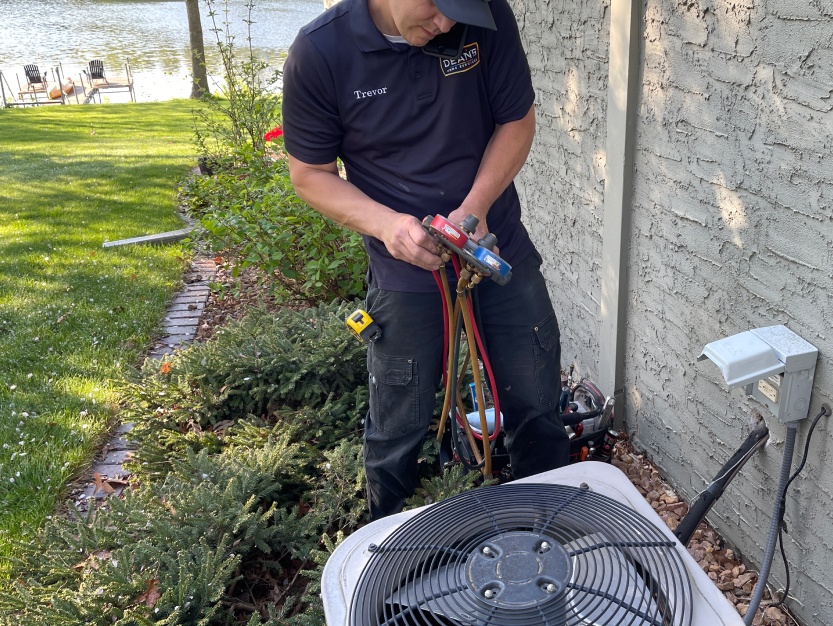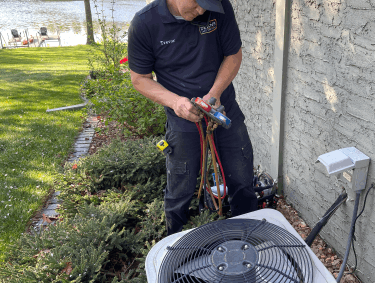What is a Heat Exchanger and How Does it Work?

An HVAC heat exchanger is a critical part of your HVAC system. Also referred to as a condenser coil in air conditioners, this component plays a crucial role in maintaining a safe and comfortable indoor environment. If your heat exchanger becomes damaged, it could cause toxic gases to mix into your home’s air. Therefore, keeping your heat exchanger fully operational is essential.
Dean’s Home Services in Minneapolis and St. Paul, MN, boasts over 100 combined years of industry experience. Contact us immediately if a damaged heat exchanger is putting your family at risk.
What is a Heat Exchanger?
A heat exchanger enables your HVAC unit to transfer thermal energy from one point to another. These systems are slightly different depending on the kind of HVAC appliance. A heat pump or air conditioner has a refrigerant-based heat exchange system. A furnace heat exchanger provides a holding chamber for the hot gases of combustion to be exposed to the air moving through the vents. Electric furnaces don’t require a heat exchanger as air can blow directly over the resistance coils.
If your HVAC system is blowing lukewarm air, your heat exchanger may pe part of the issue. Work with Dean’s Home Services to learn more.
How Does a Heat Exchanger Work?
Refrigerant system heat exchangers can be found in both heat pumps and air conditioners. The same kind of system is also used in your refrigerator.
A refrigerant system has four components that operate in a closed loop. In order to distribute heat most efficiently, these systems have a pair of linked exchangers, one indoors and one outdoors.
A paired compressor and condenser add pressure to the refrigerant. This process will generate heat. Metal fins provide additional surface area to release that heat into the air. When the heat is the desired temperature, a fan can blow over these fins to help distribute it precisely. If your goal is to cool a home, this heat exchanger releases air to the outside of the home.
Liquid refrigerant is circulated to an evaporator and expansion device, which give the refrigerant room to return to its normal, gaseous state. To facilitate this process, heat is absorbed from the surrounding air. This second heat exchanger also has additional surface area to allow as much interaction with the outdoor air as possible.
In a combustion furnace, the heat exchanger takes the flue gases that are released from burning the propane, natural gas, oil or other fuel. The chamber that holds this gas is made of metal that absorbs the heat from the gas. Air blows across the exterior of the heat exchanger, pulling the warm air into the ductwork.
Highly efficient furnaces will have both a primary and a secondary heat exchanger. The secondary exchanger acts as a condenser, allowing moisture to condense out of the air. This process will remove additional heat from the air and make the furnace even more efficient. Like the primary condenser, this chamber is made of metal to help distribute the heat outside to where the fan can blow the warmed air.
Why Are Heat Exchangers Important?
Heat exchangers offer some important things to Minneapolis and St. Paul homes.
1. Temperature Regulation
Heat exchangers create a more comfortable indoor environment. For example, transferring hot air from inside your home to outside makes summertime temperatures more bearable.
2. Air Quality
Certain heat exchangers, including air-to-air ventilation systems, help improve indoor air quality too. This is done through exchanging stale air with fresh air.
3. Energy Efficiency
If your heat exchanger is working effectively, it will minimize energy loss. In other words, your system can enable you to spend less money on heating and cooling.
Signs of a Failing Heat Exchanger
Many heat exchanger issues are due to leaks. There are several signs that can indicate this.
Soot
If there is soot coming out of your vents, this is a sign that your heat exchanger is not fully expelling the combustion gases out of your home. This can expose you to dangerous gases like carbon monoxide.
Odd Odors
Your furnace may emit a musty smell when it’s first turned on, but this should go away after a few minutes. If it doesn’t, it’s an indicator of a possible heat exchanger issue. This may smell like burning if it’s a furnace or like chemicals if you have a refrigerant leak.
Health Symptoms
Experiencing unexplained health issues when your HVAC is running may indicate a big problem. Other signs to watch out for include fatigue, dizziness, nausea and headaches.
Have you been dealing with any of the above issues? Our team has been solving them for more than 100 years.
Proudly Serving the Twin Cities
As a female and minority-owned business, we offer Dean’s Club Memberships to help you cut down on HVAC repair bills. Aside from heat exchangers, we also handle heating and cooling repairs, preventative maintenance, and installations. Call Dean’s Home Services today to learn more.







- Free annual evaluations
- 10% discount on repairs and equipment
- Priority scheduling
- No regular travel charges
- Discounted after-hours travel charges


